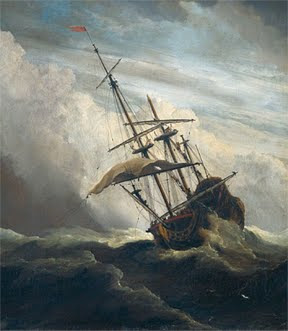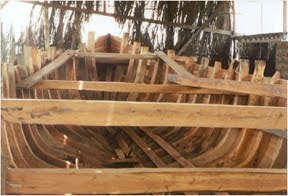If Lehi was to travel the course that traders were traveling around the Arabian Sea and the coastal waters of Indonesia as so many claim, then why build a ship unlike that already being built by man? Consider:
1. Nephi grew up around Jerusalem. From Jerusalem: The Dead Sea is 14 miles. The Jordan River is 19 miles east. The Mediterranean Sea is 34 miles to the West. Surely, Nephi had seen the various vessels man had built to move and sail upon the waters.
2. When Lehi led his family south toward the sea port of Ezion-geber, and then down the shores of the Red Sea where vessels of all kinds sailed, Nephi obviously would have seen these ships and their design.
3. The Arabian dhow with its lateen sail was considered a very effective coastal vessel in the Arabian Sea. Oar-driven ships could cross the Mediterranean with ease. But these vessels were not what the Lord had in mind.
4. Ships of one type or another sailed these waters since at least the time of Solomon who had a fleet of ships at Ezion-geber (2nd Chronicles 8:17-18), and traded with various centers around the Arabian Sea. He also would have had access and knowledge of the seafaring technologies of the Phoenicians, and traded with Tarshish (1 Kings 10:22), and received ivory, apes, and peacocks which are all native to the jungles in India.
Thus, we can see, that the knowledge of sailing and vessels was not unknown to the land from which Lehi came, and certainly would have been known enough to Nephi for him to state that “Now I, Nephi, did not work the timbers after the manner which was learned by men, neither did I build the ship after the manner of men; but I did build it after the manner which the Lord had shown unto me; wherefore, it was not after the manner of men.” (1 Nephi 18:2).
So WHY was Nephi’s ship built so different than the way men were building vessels and ships in his day? The obvious reason can only be that Nephi’s ship was going somewhere that ships of his day did not go and, therefore, had to be constructed differently than other ships.
So what was the difference?
 In building ships intended to sail into deep water, that is, far out into the ocean, rather than along coasts and around islands, the main requirement is strength. Deep ocean vessels must be able to withstand the constant pounding of waves, and the twists and turns that rough seas force upon the hull construction. The longer the vessel, the greater the torque exhibited. Also, the air interacting with sails creates various forces, including actio et reactio—Newton’s Law that forces always occur in pairs—action and reaction, the net force upon the sails. This force also brings great pressure on masts and the deck, as well as wave movement against the exterior timbers.
In building ships intended to sail into deep water, that is, far out into the ocean, rather than along coasts and around islands, the main requirement is strength. Deep ocean vessels must be able to withstand the constant pounding of waves, and the twists and turns that rough seas force upon the hull construction. The longer the vessel, the greater the torque exhibited. Also, the air interacting with sails creates various forces, including actio et reactio—Newton’s Law that forces always occur in pairs—action and reaction, the net force upon the sails. This force also brings great pressure on masts and the deck, as well as wave movement against the exterior timbers. As an example, prior to the 14th Century A.D. all ships were built in the clinker style, that is, overlapping hull planking, which worked well on short and small vessels. However, as ships grew in length, strength was sacrificed in clinker style design, which was replaced by the Carvel planking that gave strength to the hull, and greater hydrodynamic movement. Under the torsional forces of rolling waves, the greater rigidity of carvel built construction became necessary for larger non-coastal vessels, as the twisting forces grew proportional to displaced weight. The physics of this imposed an upper limit on the size of clinker built vessels. Later carvel-built sailing vessels exceeded the maximum size of clinker-built ships by several orders of magnitude.
As an example, prior to the 14th Century A.D. all ships were built in the clinker style, that is, overlapping hull planking, which worked well on short and small vessels. However, as ships grew in length, strength was sacrificed in clinker style design, which was replaced by the Carvel planking that gave strength to the hull, and greater hydrodynamic movement. Under the torsional forces of rolling waves, the greater rigidity of carvel built construction became necessary for larger non-coastal vessels, as the twisting forces grew proportional to displaced weight. The physics of this imposed an upper limit on the size of clinker built vessels. Later carvel-built sailing vessels exceeded the maximum size of clinker-built ships by several orders of magnitude.  These ships had the internal strength to support a deep keel—necessary to sail in deep oceans—and stronger decks. These decks were structural members tying the ship's frames or ribs together over the keel and overlapped horizontal beams that maintained the hull’s integrity against ocean waves and rough seas. Thus, the thickness of the decking affects how strong the hull is, and is directly related to how thick the skin of the hull itself is, which is of course related to how large the vessel is, the kind of work it is expected to do, and the kind of weather it may reasonably be expected to endure. Today, a traditional wood deck would consist of planks laid fore and aft over beams and along carlins, the seams of which are caulked and paid with tar.
These ships had the internal strength to support a deep keel—necessary to sail in deep oceans—and stronger decks. These decks were structural members tying the ship's frames or ribs together over the keel and overlapped horizontal beams that maintained the hull’s integrity against ocean waves and rough seas. Thus, the thickness of the decking affects how strong the hull is, and is directly related to how thick the skin of the hull itself is, which is of course related to how large the vessel is, the kind of work it is expected to do, and the kind of weather it may reasonably be expected to endure. Today, a traditional wood deck would consist of planks laid fore and aft over beams and along carlins, the seams of which are caulked and paid with tar.The primary or upper deck is the horizontal structure which forms the 'roof' for the hull, which both strengthens the hull and serves as the primary working surface. Its purpose is structural, and only secondarily to provide weather-tightness, and to support people and equipment. The deck serves as the lid to the complex box girder which is the hull. It resists tension, compression, and racking forces. The deck's scantling is usually the same as the topsides, or might be heavier if the deck is expected to carry heavier loads. The deck would be reinforced around deck fittings such as the capstan, cleats or bollards.
No coastal vessel, or ships built in 600 B.C. had such extensive and strong construction since it was not needed to sail in the basically calm Mediterranean and around the coastal area of the Arabian Sea. However, Lehi was being sent across the “many waters” of deep oceans to the Land of Promise and needed a ship that could withstand the hazards of such a strenuous voyage. Thus, it was not built after the manner of men, but after the design of the Lord given to Nephi.




No comments:
Post a Comment